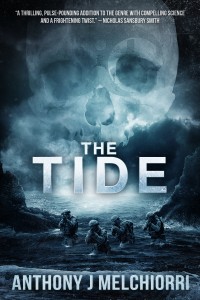The Tide: Apocalypse and Biology
The Tide rolled in this week, and I couldn’t be happier with its reception. As of writing this, it has topped out at #1 in the Horror category on Amazon and #2 in Medical Thrillers. It was a blast to write, and I can’t wait to get the next book in the series out there. Currently, The Tide: Breakwater is set to release by December 28, 2015. If all goes well, it may even be out earlier…Tide 3 is already in the works, too! It’s going to be a Skull-filled, apocalyptic season for my writing over the next couple of months.
You can pick it up here on Amazon.
***SPOILER ALERT***
If you haven’t read the book yet, this gives away some of the components of the nefarious Oni Agent featured in the book.
My initial idea for the bioweapon came from my interest in nanotechnology. Through my research in biomedical engineering, I’ve worked with nanoparticles before and the idea that something so tiny can have a huge impact on a living organism as large as a human really sparked something for me. And while nanoparticles are cool, I thought there must be something even cooler on the nano-scale. Somehow, through a bit of Google-Fu, I came across the concept of nanobacteria. I thought this sounded funky enough. Plus, there’s quite a bit of debate over whether or not these things even exist since they’re much smaller than the normally accepted size for a living organism. Interestingly, these little guys have been suspected of causing things like kidney stones by secreting calcium apatite (a major component of bone). So I thought, “Hey, maybe someone engineered a particularly nasty brand of nanobacteria that does more than just make kidney stones…” (I mean,heck, kidney stones are pretty bad as it is, so this must have been a truly evil person, right?)
You might’ve noticed in the book that Dr. Lauren Winters mentioned an NIH study on chelation treatment. That study, too, is real. Now the NIH study doesn’t mention nanobacterium per say, but I thought such a treatment might be useful for Skulls given the chelation treatment the NIH study examined was implied to have reduce the deleterious effects of calcified tissues in the cardiovascular system. Boom,we have our treatment for knocking out those nasty nanobacterium.
Anyway, that’s just a small behind the scenes look at one of the scientific aspects of the book. I love doing this type of research and mixing in a bit of fact with fiction to give us a more believable zombie-esque monster. Hope you enjoyed it, too!
Thanks for reading!

